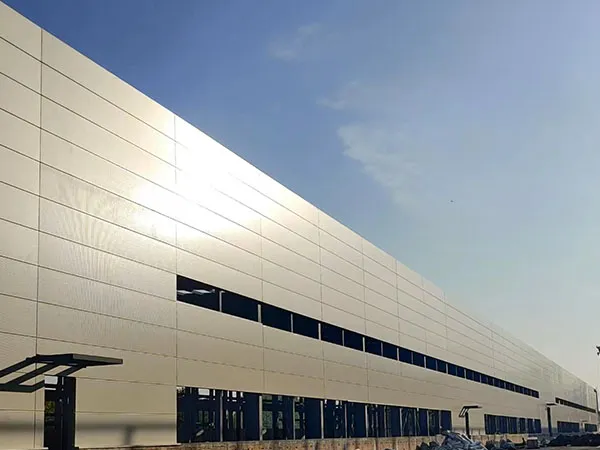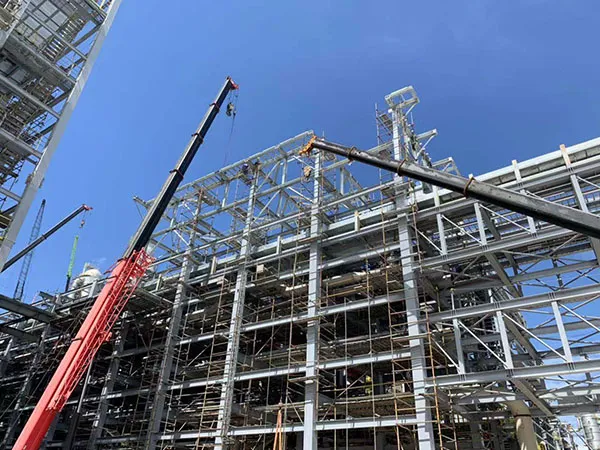Time:2025-06-13 02:26:06 Source:Sanjian Meichen Steel Structure
In modern industrial production, steel structured factories are highly sought after for their efficient construction, exceptional strength, and flexible design. However, like any industrial facility, the long-term safe and stable operation of steel-structured factories requires systematic and professional maintenance. Neglecting routine maintenance not only shortens the lifespan of the factory but can also lead to serious safety hazards and high repair costs. This article will delve into the key aspects of steel-structured factory maintenance and provide a comprehensive maintenance strategy.
The Importance of Steel Structure Factory Maintenance Cannot Be Overestimated
Steel structure factories are exposed to a variety of environments for long periods of time, enduring the erosion of natural factors such as wind, rain, snow, sunlight, corrosive gases, and even earthquakes. Furthermore, equipment vibration, chemical spills, high temperatures, and high humidity during the production process can also impact their structures. Regular maintenance and servicing can:
Ensure the safety of personnel and equipment: Promptly detect and repair potential structural defects to prevent accidents such as collapse and falls.
Extend the service life of the structure: Slow down processes such as steel corrosion and fatigue aging, maximizing its design life.
Reduce operating costs: Preventive maintenance is far more cost-effective than post-event large-scale repairs.
Maintain production continuity: Avoid production stoppages due to structural problems and ensure smooth progress of production plans.
Improve corporate image: Maintaining a good factory environment demonstrates the company's commitment to safety.

A comprehensive maintenance plan should cover daily, periodic, and special inspections.
1) Key Points for Daily Inspections
Daily inspections should be conducted by plant management or designated personnel, focusing on visible abnormalities:
Connector Inspection: Observe bolts and welds for looseness, cracking, deformation, or rust. Pay particular attention to any signs of slippage on the friction surfaces of high-strength bolted connections.
Anti-corrosion Coating Condition: Inspect the anti-corrosion coating on steel components for integrity and for signs of blistering, peeling, cracking, or powdering. Any coating damage could expose the steel to a corrosive environment.
Roof and Wall Panels: Inspect roof and wall panels for damage, leakage, or deformation. In particular, for color-coated steel roofs, inspect lap joints, sealants, and skylights (if applicable) for deterioration or cracking.
Drainage System: Ensure gutters and downspouts are unobstructed and free of blockage, water accumulation, or damage. Failure to drain rainwater promptly is a major cause of internal moisture and structural corrosion.
Doors, Windows, and Lighting and Ventilation Facilities: Inspect them for proper opening and closing, proper sealing, and any damage. Support System: Observe support rods and tie rods for bending or looseness to ensure they provide stable support.
2) Regular (quarterly/annual) Professional Inspections
In addition to routine inspections, a comprehensive inspection by a professional engineer or third-party testing agency is recommended annually or semi-annually:
Structural Deformation Measurement: Use specialized instruments to inspect the verticality, deflection, and flatness of major load-bearing components such as beams, columns, and trusses. Compare these to design values to assess any excessive deformation.
Ultrasonic/Magnetic Particle Inspection of Welds: Perform non-destructive testing of critical welds to identify internal defects such as cracks, slag inclusions, and air holes.
High-Altitude Component Inspection: Use drones or lifting platforms to conduct close-up inspections of rooftops and high-rise steel structures. This is especially important for areas that are difficult to access on a daily basis.
Lightning Protection Grounding System: Check that the grounding wire is securely connected and that the grounding resistance meets specifications to ensure lightning protection safety. Fire Retardant Coating Performance Assessment: Components coated with fire retardant coatings require regular assessment of coating thickness, adhesion, and integrity to ensure adequate fire resistance in the event of a fire.
Fastener Torque Review: Critical bolted connections, especially high-strength bolts, should be torque-rechecked to prevent loosening.
3) Special Inspections (for Special Situations)
After Natural Disasters: Immediately after strong winds, heavy rain, earthquakes, or heavy snowfall, a comprehensive inspection must be conducted to assess structural damage.
Heavy Equipment Installation/Modification: When installing new equipment or modifying production lines within a factory, the impact on the load-bearing capacity of the existing structure must be assessed.
Significant Abnormalities: When serious structural issues are discovered during routine inspections, special inspections and assessments should be initiated immediately.

1) Anti-corrosion Treatment and Maintenance
Anti-corrosion is the core of steel structure maintenance.
Rust Removal and Recoating: Once rust is detected on the steel surface, immediate localized rust removal should be performed to a St2 or Sa2.5 standard. Then, a recoat (primer, intermediate, and topcoat) should be applied using the original anti-corrosion system or a more optimal solution.
Anti-corrosion Coating Selection: Based on the workshop environment (e.g., humidity, chemical corrosion, etc.), select an appropriate anti-corrosion coating system, such as epoxy zinc-rich primer, epoxy micaceous iron intermediate, or polyurethane topcoat.
Regular Cleaning: Remove dust, oil, and chemical residue from the steel structure surface to reduce the adhesion of corrosive media.
2) Fastener Replacement and Reinforcement
Bolt Replacement: Bolts that are severely corroded, deformed, or stripped must be promptly replaced with new bolts of the same grade.
Weld Repair: Any defects such as cracked welds or incomplete weld penetration should be repaired by a professional welder according to specifications and quality inspected. Structural Reinforcement: When a structure's bearing capacity is insufficient or components are severely damaged, reinforcement measures such as adding supports, attaching carbon fiber cloth, or increasing cross-sections may be necessary.
3) Roof and Wall Waterproofing
Waterproofing Repair: If a roof or wall leak is discovered, the leak should be immediately located and the waterproofing layer repaired or damaged panels replaced.
Sealant Renewal: Regularly inspect and replace aging sealant to ensure the tightness of lap joints.
Drainage System Maintenance: Regularly clear leaves and debris from gutters and downspouts to ensure smooth drainage.
4) Fire and Lightning Protection System Maintenance
Fire Retardant Paint Maintenance: Damaged or peeling areas of fire retardant paint should be promptly repaired or recoated.
Lightning Protection Grounding Inspection: Ensure that the grounding resistance meets specifications and that the grounding connection is intact.

Case 1: Corrosion Challenges at a Chemical Plant
A chemical plant located in a coastal area and exposed to an acid mist environment experienced unexpected degradation of its steel structure's anti-corrosion coating. Through regular coating thickness testing and localized repairs, and the introduction of a more advanced heavy-duty anti-corrosion coating system, we effectively extended the corrosion protection period and reduced long-term maintenance costs.
Case 2: Structural Deformation Caused by Ground Settlement in a Heavy-Duty Workshop
At a heavy machinery manufacturing plant, localized ground settlement led to uneven settlement of some steel column foundations. Through precise deformation monitoring combined with finite element analysis, we ultimately implemented foundation grouting reinforcement and localized structural unloading and correction, successfully restoring the structural stability and safety.
An effective maintenance plan should include:
Clear Responsibilities: Designate a dedicated maintenance team or person in charge.
Detailed Checklists: Develop detailed inspection checklists and maintenance procedures.
Record Management: Keep detailed records of each inspection, maintenance, and repair work, including the date, content, issues discovered, solutions, and responsible personnel. These records are crucial for assessing plant condition and optimizing maintenance strategies.
Professional Training: Provide professional training to maintenance personnel, equipping them with the skills to identify potential issues and perform basic maintenance tasks.
Budget Security: Provide adequate funding for maintenance efforts.
Steel structure plants are important fixed assets for businesses, and their maintenance is a long-term, ongoing undertaking. Through a scientific and systematic maintenance strategy, we can not only ensure the safe and stable operation of the plant and extend its service life, but also provide a solid foundation for the sustainable development of the business. If you encounter any questions regarding steel structure plant maintenance or require professional assessment and support, please feel free to contact us. We are happy to assist you.